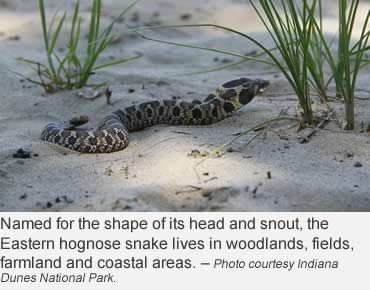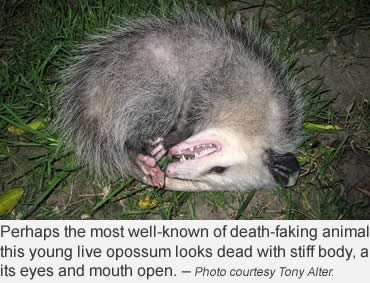Photo: Is it really dead or is this snake playing possum? – Photo courtesy Douglas Mills.
People who study reptiles and some who simply like snakes often become very cheerful when they encounter an Eastern hognose snake on a hiking trail.
Why would they be cheerful?
If the hognose snake thinks it’s being threatened, it may pretend it's dead, and its spectacular death-bluffing behavior is very entertaining.
The harmless hognose snake raises its head, puffs up, hisses loudly and flattens its neck, imitating a cobra’s hood. It may also lunge at the perceived threat, which may be why it can be mistaken for a rattlesnake with its thick body and triangular-shaped head.
 If it is a mature hognose snake at 20 to 30 inches long, that death-bluffing behavior quite a sight, but some have been known to reach up to 46 inches in length. The bluffing behavior of a 46-inch hognose snake would make anyone take a step back!
If it is a mature hognose snake at 20 to 30 inches long, that death-bluffing behavior quite a sight, but some have been known to reach up to 46 inches in length. The bluffing behavior of a 46-inch hognose snake would make anyone take a step back!
On another note, it doesn't bite.
If the hissing and puffing-up behavior fails to scare away a potential predator, the hognose rolls over and plays dead, with its mouth open and tongue hanging out. For good measure, it may regurgitate its last meal—usually a partially-digested toad—and release a foul scent.
Now is the time to wait and watch. Slowly, one snake eye opens just enough to survey the possibility of danger. If the hognose feels safe after being undisturbed, it will right itself and move away. But if someone or something attempts to roll it over from its back during its death performance, it rolls back and continues to play dead.
This death-faker is one of several animals known to use this self-protective instinct. The hognose has a lot in common with another famous death faker, the American opossum, the original source for the phrase “playing possum.”
Death faking is called thanatosis, a proven way to trick predators, real and perceived.
 Possums also use scents in their death-faking act, but they are just one of the few warm and cold-blooded animals around the world that can play dead, including some frogs, birds, sharks, spiders and other snakes.
Possums also use scents in their death-faking act, but they are just one of the few warm and cold-blooded animals around the world that can play dead, including some frogs, birds, sharks, spiders and other snakes.
Because of this behavior, the hognose snake has also been called a puffer belly, a spread head, and a sand viper among other descriptive names.
Named for its upturned nose used to dig, there are Eastern hognose and Southern hognose snakes as well as Western hognose and Mexican hognose snakes, which can found in the United States from Canada to Mexico and coast to coast. They inhabit woodlands with sandy soils, fields, farmlands and coastal regions.
Eastern hognose snakes favor dining on toads, something most predators ignore because of the toad skin toxins. The hognose snake has a pair of enlarged teeth in the back of its mouth it uses to puncture inflated toads before consuming them. Their unique salivary glands contain a mild venom which is harmless to other animals and humans, but helps them eat amphibians.
Their coloration varies from almost solid black to brown and olive, but they may also have irregular patterns and dark blotches on their back. Their undersides are usually lighter in color.
Unfortunately, being mistaken for a venomous rattlesnake sometimes ends badly for hognose snakes.
– Resources: Alabama Department of Conservation and Natural Resources, South Carolina Department of Natural Resources, the U.S. Forest Service.